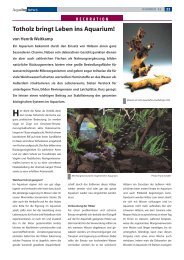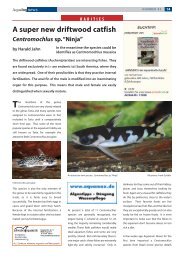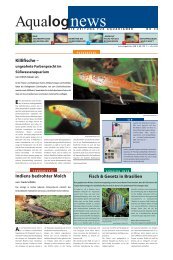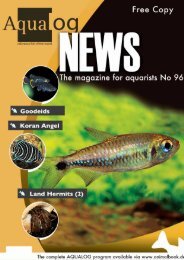LIVEBEARERS T Phallichthys tico - - a dainty new ... - Aqualog
LIVEBEARERS T Phallichthys tico - - a dainty new ... - Aqualog
LIVEBEARERS T Phallichthys tico - - a dainty new ... - Aqualog
Create successful ePaper yourself
Turn your PDF publications into a flip-book with our unique Google optimized e-Paper software.
<strong>Aqualog</strong><strong>new</strong>s NUMBER 94 11<br />
The Jaguar Angelfish<br />
by Roman Neunkirchen<br />
T<br />
his often leads to hybrids between<br />
different species, and invariably<br />
combines genetic material from<br />
individuals that are only very distantly<br />
related. The result is an increased<br />
F ANCY FISH<br />
Angelfishes are among the most popular of all ornamental fishes.<br />
Because the systematics of these fishes has to date been studied only<br />
very inadequately, individuals from totally different geographical<br />
regions have been (and still are) frequently mated to one another.<br />
Angelfish of the “jaguar” cultivated form. Photos: Frank Schäfer<br />
occurrence of genetically dictated changes that may affect<br />
coloration or even body form – we have only to think of the veiltailed<br />
forms. Accidental mutations can be genetically fixed<br />
relatively quickly through back-crossing to the parents. This is<br />
how <strong>new</strong> cultivated forms usually arise.<br />
Wild angelfishes - a single species?<br />
It is, of course, also the case that <strong>new</strong> variants can suddenly turn<br />
up in long-bred strains as a result of mutation. But this happens<br />
comparatively less frequently. Be that as it may, it is very<br />
noticeable that it is those species of aquarium fishes that already<br />
occur in the wild in a large number of different-colored<br />
populations – examples are the Guppy and Platy – that very<br />
rapidly give rise to a wide variety of<br />
cultivated forms. Here too the boundaries<br />
between “variant” and “species” are fluid<br />
and not sharply drawn, precisely as in the<br />
angelfishes. Pterophyllum scalare is very<br />
widely distributed in Brazil, French Guiana,<br />
Guyana, Columbia, and Peru and numerous<br />
local populations also have their own<br />
names in the hobby: examples are the<br />
“Peruvian Altum”, the “Redback”, the<br />
“Eimekei”, etc, all technically members of<br />
the species P. scalare.<br />
Cultivated forms – only for beginners?<br />
It is a great pity that the precise origins of<br />
cultivated forms of aquarium fishes are<br />
generally only very inaccurately or<br />
anecdotally documented. The reasons for<br />
this are manifold, but usually commercial<br />
interests are at the root of the secrecy.That







